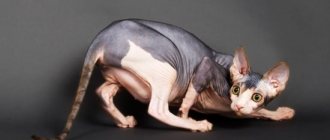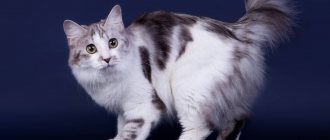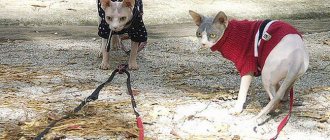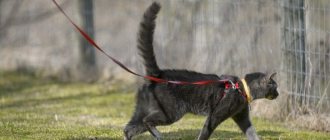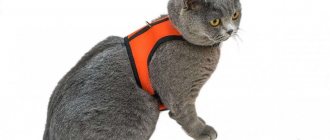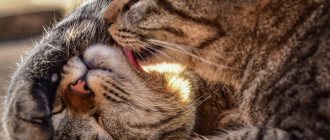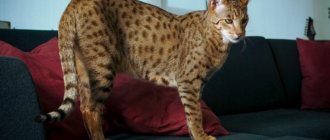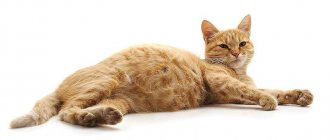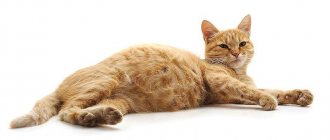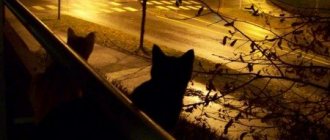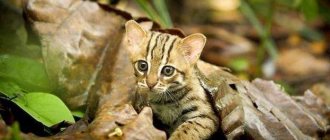For the most part, our world is divided into cat lovers and dog lovers. We offer a list of cat breeds that behave like dogs, some of them even wag their tails to express their joy.
Representatives of these breeds are excellent at learning commands and are ready to accompany their beloved owner on walks, shopping trips, etc.
Therefore, if you just can’t decide to get a cat or dog, or your family is divided into cat and dog lovers, consider the cat breeds we offer, perhaps you will find in one of them a combination of the necessary qualities and a long-awaited pet will appear in your home.
Top 5 cat breeds with dog-like devotion
There are cat breeds that are more like dogs in loyalty and character.
There is an opinion that cats are selfish and independent animals. But it is not so. Cats, like dogs, are very attached to their owner and get bored in his absence. But there are breeds that are not shy about expressing their feelings and their devotion borders on that of a dog:
Neva masquerade cat
Fluffy, good-natured cats of this breed simply adore children and allow them to do whatever they want with them. Only a dissatisfied but patient face will remind you of the inconvenience. They are very sad without the company of their owner. So much so that they can get sick from grief during a long separation.
Maine Coon
The breed is famous not only for its size, but also for its truly canine devotion. They are very observant and clearly grasp the mood of the owner, knowing when to approach him and when not. Maine Coons will never show their claws in play and will look after your child as if they were their own.
Abyssinian cat
This breed is considered the most loyal to its owner. Abyssinians are famous for their intelligence, activity and curiosity. These features should be taken into account when choosing a breed. These cats literally have a motor inside them; the Abyssinian will certainly want to participate in all your affairs and will accompany you everywhere.
Oriental cat
Their elongated muzzle and extremely large ears make them look like aliens. Orientals get along well with people and have a neutral attitude towards other pets in the house. But they choose only one owner for the rest of their lives, and are endlessly devoted to him, having a hard time experiencing separation.
Cornish Rex
Short curly fur, incredibly long legs and high activity. Here are the main features of this breed. Cornish Rexes are easy to train, very intelligent and have a truly canine character.
When choosing your future pet, remember that only by devoting enough time to it you will receive boundless love and affection in return.
Breed description, standards, appearance
This breed, according to the Fédération Cynologique Internationale classification, is included in group number 5, which is called “Spitz and primitive breeds.”
There are only three varieties of Xoloitzcuintle dogs. They differ from each other in body size.
TypeHeight at withers, cmWeight, kg
| Standard | 46-60 | 9-14 |
| Average | 35-45 | 6-10 |
| Mini | 25-35 | 4-8 |
Size and constitution
According to scientists, Aztec dogs, the ancestors of modern Xoloitzcuintles, belonged to the first, larger type. The body length of representatives of this breed is approximately 10% greater than the height at the withers. The body of males is slightly shorter than that of females. Dogs of both sexes look lean and fit.
Characteristics of the animals' exterior:
The dog moves freely. Her stride is long and elegant, and her trot is fast and smooth. While moving, the dog should hold its head and tail high.
Color and skin
From the photo of the Xoloitzcuintle, you might think that this is a dog without hair. However, hairless representatives of the breed still have a short and very sparse covering on the back of the head, on the forehead, toes and tip of the tail. The length of the hairs should not exceed 2.5 cm.
The breed also has a woolly variety. Such animals have cover all over their body. It is even, smooth and short, and there is no undercoat. Woolly dogs can participate in breeding provided that they are well built, have a beautiful exterior and color allowed by the standard.
The Mexican Hairless Dog has delicate, smooth and very sensitive skin that requires special care. Light-colored animals are susceptible to sunburn and therefore need protection from scorching rays. The Xoloitzcuintle's skin is hot to the touch.
The heat generated by the body is not retained in the fur due to its absence, so such dogs can freeze. The animal's body does not sweat when overheated. Cooling occurs through the paw pads and membranes between the toes.
Attention! Xoloitzcuintle puppies are covered in folds of skin. They are concentrated in the neck, head and forearms. As the animal grows, they become almost invisible. The standard allows the presence of shallow wrinkles on the forehead of adults.
Mexican dogs can have the following colors:
The standard allows the presence of points. The main thing is that they do not occupy more than a quarter of the surface of the dog’s body. The color of the nose also depends on the color of the animal. So, in Xoloitzcuintles with dark skin tones, it is almost black. In representatives of the breed with a bronze or golden color, this part of the body may be brown, or less often – flesh-colored.
In dogs with points, the nose most often has spots on the body.
The color of the iris should match the color. It happens:
- yellow;
- amber;
- coffee;
- brown;
- black.
Maine Coon
Owners of this breed often notice their dogs' habits. Despite their stern appearance, which supposedly indicates that it is better not to approach them, Maine Coons are very friendly.
They treat people around them and other pets with great sympathy, just like dogs. In addition, they are very loyal to their owners and are ready to stand up for all family members.
Puppy care
When purchasing a dog, the breeder will give detailed recommendations on caring for the Xoloitzcuintle. After moving to a new house, you need to surround it with attention and care, play together, and walk outside. All this will help the puppy quickly recover from stress after separation from its previous owner and adapt.
One of the most important aspects of caring for a Xoloitzcuintle puppy is nutrition. Young animals are fed more often than adult dogs.
- At the age of 2 to 4 months, babies should eat 4-5 times a day.
- In the period from 5 to 9 months - 3 times a day.
- As dogs approach one year of age, they are gradually transferred to two feedings a day.
Xoloitzcuintle price
A pet-class Xoloitzcuintle dog costs about 10,000-15,000 rubles. This is an animal with documents, but there are flaws in its appearance that do not allow it to be used for breeding. Prices for breed class dogs range from 30,000-80,000 rubles.
The most expensive are exhibition animals, which can participate in various shows, championships and win awards. The cost of such dogs can reach 150,000 rubles.
The bald native of Mexico is undoubtedly worthy of attention, if only because she has a unique appearance. However, when choosing a pet, this is not the only thing to consider. It is much more important to choose an animal to suit your own temperament. The Xoloitzcuintle needs a strict but loving owner who will not allow the dog to break the established rules and push himself around.
Care and maintenance
The Xoloitzcuintle dog is an ideal pet for an apartment or private home. She does not require much free space, as she is moderately active. Keeping an open-air enclosure outside is not suitable for an animal without fur.
Caring for a Mexican dog includes:
- carrying out hygiene procedures;
- diet planning;
- regular walks in the fresh air;
- dog training.
Hygiene procedures
Lack of hair does not mean that the Xoloitzcuintle is easier to care for. Yes, such a dog does not need combing, but its skin requires a more careful approach. Over time, a sticky coating forms on it, to which dust and lint stick. Therefore, your pet’s body needs to be washed regularly. About once every 2 months, the dog is bathed in a bath using hypoallergenic products.
In between water procedures, the Xolo's skin is wiped with animal cleansing wipes. You can use children's ones as they do not contain alcohol.
The Mexican dog requires careful care in the summer. Before going for a walk, it is advisable to apply sunscreen to your Xoloitzcuintle's skin. However, even when using it, it is better to walk in a shady park. When the heat is intense, the Mexican dog's skin quickly loses moisture and may peel. In this case, it is recommended to lubricate the pet’s body with olive oil.
Attention! Dogs of this breed may develop rashes on their bodies up to eight months of age. Special lotions and finely abrasive scrubs help cope with this problem. If a rash bothers an adult animal, it is most likely a manifestation of an allergy.
It is important to monitor the condition of your ears. Once a week they are cleaned with a cotton pad soaked in hygienic lotion. During the procedure, dirt is removed only from the external auditory canal. The inner corners of the eyes are wiped daily with a clean napkin or sponge.
The dog’s mouth also needs care. Teeth are brushed every 2-3 days with a special paste for animals. To prevent the formation of tartar, dental treats are introduced into the xoloitzcuintle's diet.
Twice a month, the dog's nails are trimmed so that it does not feel discomfort while walking. Scissors are not suitable for this. It is better to buy a guillotine-type nail clipper. It has an oval hole where the tip of the claw is inserted and quickly cut off. It is important to accustom your Xloitzcuintle puppy to hygiene from an early age, then the dog will behave calmly during unpleasant procedures.
Feeding
Xoloitzcuintles are prone to allergies, so their diet must be carefully monitored. You cannot feed a dog food from a human table. Representatives of the Mexican breed have an excellent appetite, so they can gain excess weight if the owner constantly follows the lead of a cute beggar.
Industrial feed
Veterinarians and professional breeders advise feeding Xoloitzcuintles with premium industrial food. They are properly balanced and contain all the necessary substances and vitamins for the normal development of the dog.
The best option is to switch your pet to dry food, since it does not spoil in a bowl even in the summer, when it is hot at home. But if your dog has dental problems, he should be given soft food.
Natural feeding
Many owners prefer to feed their Xoloitzcuintle natural food. In this case, it is important to properly balance the diet. It should consist of 60% high protein foods.
The main source of protein is lean meat:
- rabbit meat;
- chicken, turkey fillet;
- veal.
Once a week you can pamper your dog with sea fish, the main thing is to select all the bones. The Xoloitzcuintle menu also includes porridge, vegetables and fermented milk products. All dog food is prepared without adding salt or spices.
Strictly prohibited:
- pork;
- salo;
- sausage;
- sausages;
- human canned food;
- minced meat and meat that have not undergone heat treatment;
- fried food;
- smoked snacks;
- beans;
- bones;
- milk;
- bakery;
- candies.
Walking and exercise
The Mexican Hairless Dog should be walked at any time of the year, but not all weather is suitable for the boardwalk. It is better to go outside on windless, non-cold days when there is no precipitation. In autumn, early spring and winter, be sure to wear overalls on your pet. It will help prevent colds.
To maintain good shape, your dog needs moderate physical activity. Xoloitzcuintles love to run, jump and be active. Such animals love to overcome obstacles, look for a stick and bring it to the owner; they will enjoy canine freestyle classes.
Training and education
The Xoloitzcuintle has not only positive qualities. This dog is stubborn by nature, so you will have to work on shaping its character. It is important to start parenting at an early age. The dog must be taught to respect its owner and obey him unquestioningly.
With regular training, Mexican dogs learn well and easily remember commands. The main thing is that the four-legged friend feels the firm hand of the owner.
The Xoloitzcuintle does not tolerate lack of attention well. Because of loneliness, dogs often bark for no reason and behave badly.
Top 8 cat breeds with a “dog-like” character
May 1, 2021 | author: Irina Mikhalkova | Photo ru.depositphotos.com
Not only dogs, but also cats can be loyal to their owners. The authors of the blog “About Cats” said that there are at least 8 breeds of cats that are distinguished by devotion, which is in no way inferior to that of a dog.
Sphinxes are considered the most loyal
. These cats are not as independent as other cat breeds. Sphynxes are very good companions and are always close to their owner whenever possible. At the same time, these cats are very vulnerable and extremely emotional. They often require human support.
In addition to their incredibly beautiful blue eyes, they are distinguished by their devotion. They are constantly close to their owner. And they understand very well what his mood is.
Maine Coons
They are distinguished by an easy-going disposition, which is why they always fit well into the family into which they end up. They become very attached to people, especially children. But at the same time they are not at all intrusive.
Oriental cats
have a high level of intelligence. They fall selflessly in love with a person and are ready to follow on his heels. They tolerate loneliness very poorly.
Abyssinian cats
show tact. They try to use their intellectual abilities and innate instincts. They are well versed in a person's mood.
Behavior of Karilian Bobtails
somewhat reminiscent of a dog's. That is why cats of this breed can become real friends to a person. They are distinguished by their flexible character, balance and loyalty. They choose their owner for life.
Siberian cats
love to dominate the family. They are ready to argue with any animal in the house for dominance. She treats her owner with warmth and affection, thereby showing that she will never abandon him.
Ragdolls
very friendly. They become attached not only to humans, but also to all living things: birds, dogs, etc. However, ragdolls absolutely do not like to part with their friends. These cats suffer greatly from loneliness, but at the same time they cannot stand domestic scandals.
Brief history of origin
The Xoloitzcuintle breed is considered one of the oldest on the planet. According to scientists, it has existed for about 5 thousand years. This is evidenced by numerous archaeological finds in the form of frescoes and figurines. The homeland of these animals is Mexico. The Aztecs, who lived on the South American continent at that time, noticed the unusual appearance of the dogs. She seemed scary due to her lack of fur. The Indians gave the bald animals a name consonant with the name of the god of the underworld. It was Xolotl, or Xolotl.
The Aztecs believed that xoloitzcuintles helped the deceased find their way to the afterlife. Therefore, after the death of a warrior, it was customary to kill his dog and bury him with the owner. At the same time, an arrow from a dead Indian was placed in the mouth of the four-legged friend. In Mexico, archaeologists have found many such graves.
On major holidays, the Aztecs prepared delicious dishes from local hairless dogs. Then it was believed that such food would help gain the favor of the gods and endow the participants in the meal with the gift of providence. The Indians believed that Xoloitzcuintle meat strengthened male strength. According to the ancient inhabitants of South America, the Mexican hairless dog helped to cure diseases.
With the advent of Spanish conquerors on the continent, difficult times came for the Xoloitzcuintle. The conquistadors tried to eradicate local beliefs and impose their religion on the Indians. For this reason, dogs began to be destroyed en masse, since in a certain sense they were an object of worship. At that time, the breed almost disappeared from the face of the earth. Several dozen animals survived and were located in remote villages in the mountainous area.
At the beginning of the 19th century, Europeans again showed interest in the wrinkled Mexican hairless dog. Elements of clothing and accessories for noble people were made from its skin. And only in 1850 the situation changed. There were people who came to the defense of the unusual breed. Then expeditions were organized to Mexico to search for surviving dogs for breeding. The efforts of the enthusiasts were rewarded. In 1887, the breed was registered with the American Kennel Club. However, they soon forgot about her.
The Xoloitzcuintle dog owes its true revival and recognition to Norman Pelham Wright, who in 1954 went to Mexican villages. He managed to find several representatives of the ancient breed.
The naturalist began breeding work, and at the same time wrote works on the history of hairless dogs. His book was called "The Solo Mystery." Mr. Wright developed a preliminary standard. Thanks to this man, the breed was recognized in its homeland in 1956. In Europe and America, its popularity began to grow. In 2011, the Xoloitzcuintle was registered with the AKC again.
The language barrier
So, if you raise puppies and kittens together, then when they grow up, they will get along not only with each other, but also with other dogs and cats. However, the experimental situation that Michael Fox created is rare in real life. Usually a person brings into the house animals that grew up among their own kind, and he is interested in how to make sure that the pets do not poison the existence of each other and the owners of the apartment. And here the experience of other cat and dog owners will help him.
Specialists from Tel Aviv University ( Applied Animal Behavior Science
, 2008, V. 113 (1–3), pp. 150–165) compiled a questionnaire, which, along with detailed instructions, was sent to Israeli volunteers who keep both dogs and cats. The questionnaire includes 28 questions about animals (age, gender, breed, castration, chronic diseases, age at which they came into the home) and the relationship between them. Possible relationships were divided into three groups: friendly, hostile and indifferent.
Scientists received 170 completed questionnaires, from which they learned that in most cases dogs and cats living in the same house are friendly towards each other. Friendliness manifests itself in playing together.
Unfortunately, different owners can evaluate the actions of their pets differently and even give them anthropomorphic features, so such surveys are always subjective. The objectivity and reliability of the results are ensured by the data of professional observers. Their numbers, and therefore their options, are limited, and they focused on couples who get along well with each other and are older than six months, since young couples have not yet fully developed their relationships.
There were forty-five survey participants who met these requirements and allowed researchers into their homes. Two observers sat in a closed room with a cat, a dog, and their owner and watched the animals interact and play with each other for 20 minutes. The game began when the owner threw a tennis ball to the pets.
Observations have shown that cats are more likely to invite dogs to play, show aggression towards them or reactions of fear and submission than dogs towards cats. Since the cat is a solitary creature, scientists expected it to play alone or with imaginary prey, but it willingly plays with a dog. Perhaps the playfulness of cats is caused by juvenileization, in which an adult animal retains the behavior of a kitten. Juvenilization is apparently associated with domestication, as it makes the behavior of animals more flexible and facilitates their adaptation to the anthropogenic environment.
The second indicator of friendliness is mutual sniffing. It is customary for cats to sniff nose to nose as a greeting. Three-quarters of the observed cat-dog pairs greeted each other in the same way. It is curious that dogs, which sniff the rear when meeting, adopted the cat type of greeting as an adaptation to living together, that is, they explained themselves in a foreign language.
The language barrier is a serious problem. This is not about “woof-woof” and “meow”, but about body language. The meaning of some poses in cats and dogs is the same, but there are also differences. The Cheshire Cat also noted that a dog wags its tail when it is happy, and a cat wags its tail when it is angry. And that's not the only difference. Scientists observed the animals' reactions to four postures, which have opposite meanings in dogs and cats (see table).
Table.
Brief cat-dog phrasebook
| Language of the body | Meaning | |
| Dog | Cat | |
| Front legs extended | Friendliness, submission | Aggression |
| Lying on his back | Subordination | Aggression |
| Moves head to the side | Subordination | Aggression, dominance |
| Wags its tail horizontally | Friendliness, submission | Wagging the tail - aggression, wagging the tip - hunting or playing |
Body language was demonstrated during observations by 34 dogs and 40 cats. All four poses were overwhelmingly correctly interpreted by the interlocutor. Why shouldn’t dogs and cats understand each other if both have learned human body language?
Analyzing the owners' questionnaires, scientists made two practical conclusions. The likelihood of peaceful coexistence between pets increases when the kitten is no more than six months old at first meeting, and the dog is no more than a year old. This is due to the optimal period of adaptation, in which the cubs best perceive new things and learn, including foreign body language.
In addition, the relationship between the two species is better when the dog is adopted into the home last. In this case, 75% of dogs are friendly towards cats and 19% are indifferent to them. However, a cat adopted after a dog can count on friendliness only in 59% of cases, and in 32% it will be indifferent. The order of placement into the house does not affect the relationship of the cat to the dog.
The researchers expected that the cat, as a territorial animal, would not want to allow the dog into its possession, but no. The order of placement influenced the behavior of dogs, but not cats. Perhaps the fact is that the dog, having become the first pet, finds itself in the center of the owner’s attention, and it urgently needs this attention. The appearance of a kitten disrupts the established status quo, and the dog experiences this painfully, just as an older child is jealous of a younger one. A cat, a solitary animal, is less emotionally connected to its owners and does not worry if the owners also need a dog for some reason.
Cats with the character of a dog - Everything interesting and relevant
Some people love dogs more, but for some reason cannot afford to have such a pet. Cats are still more practical. They don't need to be walked. A tray with special filler or sand is enough for them. At the same time, cats feel comfortable even in the smallest apartments and can be left alone at home unattended for several days. In addition, they make less noise and dirt. Cats are very clean and require less attention.
But even all these advantages do not serve as weighty arguments for dog lovers. They are willing to endure certain inconveniences just to have a four-legged friend. If you are not one of these people, then we suggest you take a closer look at cat breeds with the character of dogs.
Rating of the best cats with the disposition of dogs
Burma
Among all such pets, Burma is the leader. This is a cat with silky brown fur and golden eyes that has adopted all the habits of a dog. She can even be taught to fetch slippers and follow some commands. You definitely won't be bored with such a pet.
Maine Coon
The name of the cat breed , Maine Coon, is also impressive Firstly, it is impressive in its size, and therefore can easily replace a small decorative dog. Her character is also far from catlike. Maine Coons do not recognize strangers, protect their territory and love to frolic.
Abyssinian cat
Third place in this ranking went to the Abyssinian cat, which loves to swim, has nothing against a leash and is always ready for walks in the fresh air. This is an excellent travel companion and just a friend who will willingly carry out basic commands. Abyssins are highly trainable.
Burmese cat
Another breed that can be raised and taught to follow commands is Burmese cats. They are very attached to their owners and are ready to give affection and warmth in unlimited quantities. It is also worth noting the attractive appearance of the pet. You can see for yourself - look at this cat breed with photos on PetStory.
If you still want a pet that will willingly accompany you everywhere and happily greet you after work, then get a Ragdoll cat. She loves to walk on a leash and is unpretentious in food and care.
Savannah
The savannah has a similar character. Only she is many times larger and amenable to training. Increasingly, there are cats of this breed that are able to perform the commands “fetch”, “sit”, “fetch a stick”, etc.
Asherah
The largest cat breed is called Ashera, which is very similar to a cheetah, but has all the character traits of a dog.
Ocelot and chausie
Those who love hunting can get an ocelot or a chausie. These cats are very graceful and are capable of hunting waterfowl or small mammals, as well as catching fish.
You can find even more cat breeds with photos and names on the PetStory resource. Here you can read all the necessary information about feeding, care and maintenance of each species.
Even more benefits from PetStory
PetStory is not an easy information resource. This is a portal that contains all the most necessary services that can make life easier for pet owners.
In particular, these are:
- searching for a clinic near your home or the required profile to provide highly specialized care;
- acquaintance with the cost of services and the opportunity to choose the most optimal option for the price;
- an online form for making an appointment with a veterinarian, and the user chooses the specialist and time independently;
- concierge chat, where you can consult with a veterinarian via video conference;
- pet-friendly map, where all places accessible to pets are marked.
Thanks to PetStory, cat owners will be able not to limit themselves to walks, provide better care to their pets and save enough time
Download the specialized application for IOS and Android Petstory using the link – https://petstory.ru/prilozhenie-konsultacija-veterinar/.
Disadvantages and disqualifying vices
The commission considers any deviation from the approved standard as a deficiency. The decision to reduce points is made taking into account the extent to which a particular defect affects the dog’s health or spoils its appearance.
The disadvantages of the breed include:
- head too wide;
- narrow body;
- short limbs;
- wrinkled skin in adult animals;
- light iris color;
- rounded eye shape;
- excessive dewlap;
- lordosis or kyphosis of the back;
- sloping croup;
- cow delivery;
- tail curled or touching the back.
Dogs that do not meet the standard and have too serious defects cannot take part in shows.
Why Xoloitzcuintles are disqualified:
- aggressive behavior;
- undershot or overshot;
- jaw distortion;
- heterochromia;
- blue eye color;
- deafness;
- blindness;
- tongue falling out of the mouth;
- short or docked tail;
- drooping or cropped ears;
- the presence of hair on the body of the hairless variety, except for the forehead, scruff, neck, tip of the tail and paws;
- long crest, like that of Chinese crested dogs;
- height less than 25 and more than 62 cm;
- any colors not provided for by the standard;
- albinism;
- cryptorchidism.
Attention! If a dog is born with extra toes, they must be removed. Otherwise, the dog will not be able to participate in exhibitions and championships.
Burma
Perhaps the Burmese cat is the most suitable option for a dog lover. She quickly gets used to the house and its inhabitants, greeting everyone at the door with joyful exclamations. The Burma loves to accompany a person in all his activities and strives to sit on his lap as soon as he sits down. The Burmese will bring an abandoned toy; she prefers active games.
The Burmese cat is naturally intelligent and has sufficient intelligence that it is easy to train.
Puberty and mating
Show and breed class Xoloitzcuintle dogs aged 2 to 6 years are allowed for breeding. In Russia, mating of dogs of different sizes is allowed. The main thing is not to cross mini animals with the standard variety. This can cause puppies to have an imbalance between bone structure and body size.
Mating of dogs is carried out on the third day of the female's estrus in the male's territory. Pregnancy lasts on average 63 days. Slight deviations in one direction or another are possible. After giving birth, the female feeds the babies with her milk for 2-2.5 months. Xoloitzcuintles are caring mothers who never give up on their offspring.
How to choose a pet
The Xolo dog is quite rare. Those interested in purchasing one will have to contact professional breeders. In Russia, there are Xoloitzcuintle nurseries in Moscow and St. Petersburg, in Ukraine - in Kyiv. In small towns it is unlikely that you will be able to find those who breed this breed.
To buy a good puppy, you need to talk to the breeder, find out more about the parents, their achievements and awards, and look at the documents. Most likely, you will have to book your dog in advance. Puppies are transferred to new families at the age of 3-4 months, a couple of weeks after revaccination against distemper, leptospirosis and intestinal infections.
The appearance of small Xoloitzcuintle puppies is a little off-putting. The baby's body is knocked down, the limbs are short, the skin is covered with folds. Such data should not confuse the buyer, since the physique will change with age, and wrinkles will smooth out.
When choosing a dog, it is better to pay attention to the animal’s temperament. It is worth giving preference to an active, playful and inquisitive puppy.
